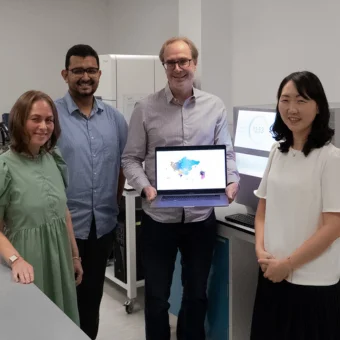Human migration in SE Asia is driven by sea-level rise, impacting genetic ancestry

- In the Media, Featured
- 07 Feb 2023
NEWS RELEASE
Prehistoric human migration in Southeast Asia driven by sea-level rise, NTU Singapore study reveals
– Findings shed light on how climate change can shape the genetics of populations in a profound way
An interdisciplinary team of scientists at Nanyang Technological University, Singapore (NTU, Singapore) has found that rapid sea-level rise drove early settlers in Southeast Asia to migrate during the prehistoric period, increasing the genetic diversity of the region today.
The Malay Peninsula and the islands of Sumatra, Borneo, and Java were originally part of a large landmass of rainforests and coastal mangroves in the South Asia continental shelf known as ‘The Sundaland’ some 26,000 years ago (Figure a).
But during the last major period of global warming in Earth’s history, from the Last Glacial Maximum period (approximately 26,000 – 20,000 years ago) to the mid-50 Holocene (approximately 6,000 years ago), sea level rose 130 metres. The rise in sea level flooded and submerged half of The Sundaland, breaking land bridges and splitting the large landmass into smaller islands of the region today.
To understand the impact on humans living in The Sundaland during one of the most dramatic sea-level rises in the Earth’s history, the team of NTU Singapore scientists reconstructed the history of the landmass using two different approaches: paleogeography – the study of historical physical landscapes, and population genetics.
Lead investigator, Assistant Professor Kim Hie Lim from NTU’s Asian School of the Environment (ASE), and the Singapore Centre for Environmental Life Sciences Engineering (SCELSE) at NTU said, “Environmental changes have profound impacts on human history, driving population migration, growth, and distribution. However, less discussed is how environmental changes can shape the genetics of populations. Our work is the first reported instance to provide proof that sea-level rise changed the genetic makeup of human populations in Southeast Asia – a legacy that continues to impact current populations.”
Using data for Southeast and South Asia’s sea-level history, including ancient Singapore records established by the NTU’s Earth Observatory of Singapore (EOS) and ASE, the research team constructed paleogeographic maps dating from 26,000 years ago to the present.
The NTU team also used whole-genome sequence data from 59 ethnic groups, including that belonging to populations native to Southeast and South Asia from 50,000 years ago. By analysing the high-quality genome data, the team was able to infer the genetic ancestry and demographic history of the groups, including their population size and distribution.
While researchers elsewhere have studied population history based on genetics, most of them used mitochondrial DNA (genes inherited from the mother), which does not tell the full picture of individual ancestry.
By using whole-genome sequence data – precise information of an individual’s entire genetic makeup inherited from both the mother and the father – the NTU study offers an unbiased demographic history of the indigenous populations inhabiting The Sundaland.
The whole-genome sequence data was generated by the non-profit organisation GenomeAsia 100K. Launched in 2016 and hosted by NTU, the initiative aims to better understand the genome diversity of Asian ethnicities by sequencing 100,000 genomes of people living in Asia.
Contributing author, Professor Stephan Schuster, President’s Chair in Genomics at NTU’s School of Biological Sciences, Research Director of SCELSE, and Scientific Chair of GenomeAsia 100K, said, “GenomeAsia 100K systematically generates maps of Asian human genetic diversity, including indigenous ethnicities who have occupied the region for a long time. Integrating those maps with paleoclimatic data allows us now to understand exactly how past climatic events have resulted in ancient human migrations, as well as their impact on today’s population structure.”
The research is aligned with the NTU 2025 strategy, where the University adopts more collaborative, global and interdisciplinary means of research to address Singapore’s national research priorities, such as health & society.
Piecing together the story of human migration in ancient Sundaland
Combining findings from the two approaches, the scientists inferred the changes in population density from the high quality historical paleogeographic maps generated.
The map paints a picture of prehistoric human migration in The Sundaland, showing that the earliest documented instance of forced human migration was driven by sea level rise.
The scientists found that two periods of rapid sea level rise (rates of sea level rise at 46mm/year and 22 mm/year) 2 promoted the separation of populations into smaller groups across The Sundaland, as the large landmass became split into smaller islands, forcing people to disperse.
Even as the landmass decreased after the rapid sea level rises, temperature increased from the Last Glacial Maximum, creating a favourable living environment to support human population growth. This caused population density to surge by at least eight times from the Last Glacial Maximum, especially in the Island Southeast Asian region, including Malay Peninsula, Sumatra, and Borneo (Figure b).
As a result, overpopulation drove people to migrate in search of new places to settle and the people in The Sundaland later migrated back northwards, towards Mainland Southeast Asia and South Asia (Figure c).
This finding is supported by evidence of migration by the ancestors of the Malaysian indigenous group (Malaysia Negrito, or commonly referred to as ‘Orang Asli’) into South Asian tribal groups (Austroasiatic speakers). Genetic analysis confirmed common genetic ancestry between the Malaysian and South Asian indigenous groups.
The entire process of migration therefore shaped the diverse ethnicities across Southeast and South Asian regions, as early settlers of The Sundaland interbred across different indigenous groups.
Co-author of the study, Dr Li Tanghua, Senior Research Fellow at NTU’s EOS said, “Based on our findings, the Orang Asli Malaysian indigenous group can be considered the first ‘casualties’ of sea-level rise, or what are known as ‘climate refugees’ today. The population had no choice but to move from their original territory due to environmental pressures. This forced migration caused an indelible change to the genetic footprint of South Asians, contributing to one of the most ethnically diverse regions in the world.”
Findings useful to understand impact of sea level rise on human ancestry
The study, published in the peer-reviewed journal Communications Biology in February, is the first to trace the impact of prehistoric sea level rise to human ancestry in Southeast Asia.
Co-author of the study, Professor Benjamin Horton, Director of NTU’s EOS, said,“The study of past sea levels is essential to predicting how increasing amounts of atmospheric carbon dioxide will alter Earth’s climate and raise future sea levels. These projections inform how societies can mitigate and adapt to climate change impacts.” Moving forward, the NTU team is looking to extend their research, to trace the story of human migration from North Asia to America, and other parts of Southeast Asia.
*** END ***
Notes to Editor:
Paper titled “Prehistoric human migration between Sundaland and South Asia was driven by sea-level rise”,
published in Communications Biology, 4 February 2023. DOI: 10.1038/s42003-023-04510-0

Figure a: A paleogeographic map of South Asia and The Sundaland in Southeast Asia over 20,000 years ago. These lands were occupied by their respective earliest settlers.
Figure b: Rising sea level flooded The Sundaland, reduced the land area and caused land splits into smaller islands, influencing multiple population dispersal and population surge, especially in the Island Southeast Asian region.
Figure c: Overpopulation in the Island Southeast Asian region drove the Malaysian Indigenous group (Malaysia Negrito, or commonly known as ‘Orang Asli’) to migrate back northwards, towards Mainland Southeast Asia and South Asia.
MEDIA CONTACT:
Pauline Teo
Assistant Director, Science Communications
Singapore Centre for Environmental Life Sciences Engineering (SCELSE)
Email: pauline.teo@ntu.edu.sg
Junn Loh
Manager, Media Relations
Nanyang Technological University, Singapore
Email: junn@ntu.edu.sg




